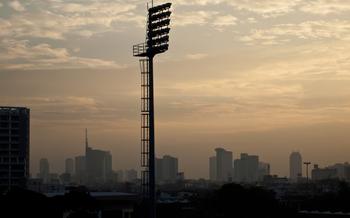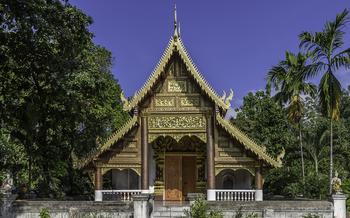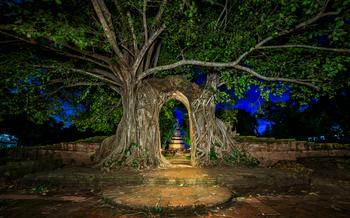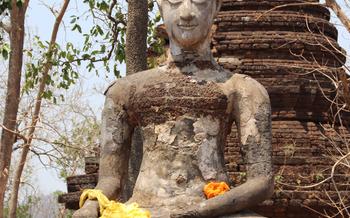
Wat Chom Khiri Nat Phrot
- Wat Chom Khiri Nat Phrot: A Journey through History and Spirituality
- Architectural Design and Elements
- Paying Homage to the Buddha Images
- Exploring the Temple Grounds
- Marveling at the Buddha Footprint
- Participating in Meditation and Dharma Talks
- Appreciating the Local Art and Crafts
- Savoring the Local Cuisine
- Interacting with the Friendly Monks
- Exploring the Surrounding Area
- Tips for Respectful Temple Etiquette
- Photography and Social Media
- Insider Tip: Hidden Gem of Meditation Retreats
Wat Chom Khiri Nat Phrot: A Journey through History and Spirituality
Situated in the heart of Nakhon Sawan, Thailand, Wat Chom Khiri Nat Phrot stands as a testament to the rich cultural and spiritual heritage of the region. The temple, which translates to 'Temple of the Mountain of the Holy Footprint,' holds a significant place in Thai Buddhism, attracting both local devotees and international visitors seeking tranquility and spiritual enlightenment.
Wat Chom Khiri Nat Phrot was constructed in the 19th century during the reign of King Rama IV. The temple's construction was overseen by a revered monk named Phra Kru Banya Sujin, who dedicated his life to preserving and promoting Buddhism in Thailand. The temple's unique architectural design and spiritual significance have made it a popular destination for pilgrims, tourists, and meditation practitioners alike.
Architectural Design and Elements
Wat Chom Khiri Nat Phrot is renowned for its distinctive architectural style, showcasing a blend of Thai and Chinese influences. The temple complex features a series of impressive structures, including a grand ordination hall, a viharn (assembly hall), and a chedi (stupa). The buildings are adorned with intricate carvings, colorful murals, and gleaming golden stupas, reflecting the artistry and craftsmanship of the era.
The most striking feature of the temple is the towering chedi, which rises majestically from the temple grounds. The chedi is believed to enshrine a relic of the Buddha, adding to its spiritual significance. The temple's viharn, where monks gather for prayers and meditation, is adorned with beautiful murals depicting scenes from the life of the Buddha, inviting visitors to contemplate his teachings.
Paying Homage to the Buddha Images
The temple is home to several sacred Buddha images, each with its unique characteristics and iconography. The main Buddha image, known as Phra Phuttha Chinnarat, is a highly revered and iconic representation of the Buddha. Enshrined in the temple's ordination hall, this majestic image exudes an aura of tranquility and serenity. Devotees flock to the temple to pay homage to this sacred image, offering prayers, flowers, and incense as a symbol of their devotion.
The unique characteristics of Phra Phuttha Chinnarat lie in its intricate details and gentle, compassionate expression. Believed to date back to the 16th century, the image is crafted from bronze and adorned with gold leaf. Its serene countenance and graceful posture have earned it a reputation as one of Thailand's most beautiful Buddha images.
Paying homage to the Buddha images at Wat Chom Khiri Nat Phrot is a deeply spiritual and meaningful experience for both locals and visitors alike. Devotees believe that making offerings to the Buddha images brings blessings, good fortune, and spiritual merit. The act of paying homage is a way to express gratitude, seek guidance, and connect with the divine.
Exploring the Temple Grounds
The design of Wat Chom Khiri Nat Phrot showcases a blend of traditional and modern architectural styles. Within the temple complex, beautifully landscaped gardens and meticulously maintained paths invite visitors to wander and soak in the serene atmosphere.
Notable landmarks and structures are dotted throughout the grounds, each holding its own significance. The main shrine, known as the Ubosot, stands as the heart of the temple, housing sacred Buddha images and serving as a venue for religious ceremonies. Other notable buildings include the Viharn, a multi-purpose hall used for Dharma teachings and meditation sessions, and the Sala Kan Parien, a pavilion where visitors can relax and take in the tranquil surroundings.
The temple grounds also feature sacred trees, ponds, and other natural elements that enhance its serene ambiance. The sacred trees, believed to possess spiritual power, are often adorned with colorful prayer flags and offerings from devotees. The ponds, filled with lotus flowers and other aquatic plants, add a touch of tranquility to the landscape.
Marveling at the Buddha Footprint
At Wat Chom Khiri Nat Phrot, one of the most significant treasures is the revered Buddha footprint, known as the Phra Phutthabat. Enshrined within a sacred chamber, this impressive footprint is believed to date back to the time of the Buddha himself, adding to its immense religious significance.
History and Origin
According to local legend, the Buddha footprint was miraculously imprinted on a large stone during his visit to Nakhon Sawan. As the tale goes, the Buddha stopped at the site to rest and wash his feet in a nearby pond. Upon lifting his foot, his footprint was left etched in the stone, leaving an eternal mark of his presence.
Religious Significance
The Buddha footprint holds profound religious significance for Buddhists, serving as a symbol of the Buddha's enlightenment and compassion. Devotees believe that paying homage to the footprint brings good fortune, blessings, and protection. Many pilgrims visit the temple specifically to venerate this sacred relic, seeking spiritual merit and a connection with the Buddha's teachings.
Rituals and Ceremonies
Various rituals and ceremonies are associated with the Buddha footprint. Devotees often perform prostrations and circumambulations around the footprint, expressing their reverence and seeking blessings. Water from the sacred pond is used to bathe the footprint, a symbolic act of purification and respect. Special ceremonies are held on auspicious days, attracting large numbers of devotees who come to pay homage and receive blessings.
Stories and Legends
The Buddha footprint at Wat Chom Khiri Nat Phrot is surrounded by a wealth of stories and legends, adding to its mystique and allure. One popular tale recounts how a group of villagers discovered the footprint while searching for a lost buffalo. Upon seeing the sacred mark, they were filled with awe and immediately constructed a temple to enshrine it, ensuring its preservation for generations to come.
Marveling at the Buddha footprint at Wat Chom Khiri Nat Phrot is a truly istimewa experience, allowing visitors to connect with the rich history, religious significance, and spiritual beliefs associated with this sacred relic.
Participating in Meditation and Dharma Talks
At Wat Chom Khiri Nat Phrot, visitors have the opportunity to immerse themselves in the spiritual teachings of Buddhism through meditation and Dharma talks. Meditation, a core practice in Buddhism, allows practitioners to cultivate inner peace, mindfulness, and focus. The temple offers various types of meditation sessions, ranging from guided meditation for beginners to intensive meditation retreats for experienced practitioners.
Dharma talks, also known as Dhamma talks, are discourses on Buddhist teachings, principles, and philosophies. These talks are typically delivered by monks or teachers who share their knowledge and insights on various aspects of Buddhism. Attending Dharma talks is an excellent way to deepen one's understanding of Buddhist teachings and gain practical guidance for spiritual growth.
To participate in meditation sessions or Dharma talks, visitors are advised to check the temple's schedule for timings and locations. The temple provides a serene and conducive environment for meditation, with designated meditation halls or quiet corners where practitioners can find solace and focus on their inner journey.
Engaging in meditation and Dharma talks at Wat Chom Khiri Nat Phrot is a transformative experience that allows visitors to connect with their spirituality, gain valuable insights, and cultivate a sense of peace and tranquility.
Appreciating the Local Art and Crafts
Wat Chom Khiri Nat Phrot is not only a significant religious site but also a hub for local artisans and craftsmen. As you explore the temple grounds, take some time to appreciate the unique handicrafts and souvenirs made by these talented individuals. These crafts are deeply rooted in Thai culture and showcase the creativity and skill of the local community.
The artisans use traditional techniques and materials to create their works, such as intricate wood carvings, delicate silver jewelry, and colorful hand-woven textiles. Each piece is unique and carries its own story, reflecting the rich heritage of the region.
The symbolism and cultural significance of the crafts are fascinating. Many of the designs incorporate auspicious symbols, such as the elephant, which represents strength and power, or the lotus flower, which symbolizes purity and enlightenment.
By purchasing these handicrafts, you not only support the local artisans but also contribute to the preservation of Thailand's cultural heritage. Your purchases help ensure that these traditional skills continue to be passed down to future generations.
So, as you visit Wat Chom Khiri Nat Phrot, remember to take some time to browse the local crafts and souvenirs. Whether you're looking for a unique gift to take home or simply want to appreciate the beauty of Thai craftsmanship, you're sure to find something special here.
Savoring the Local Cuisine
A visit to Wat Chom Khiri Nat Phrot is not complete without savoring the delectable dishes and delicacies offered by local vendors. The temple grounds are surrounded by food stalls selling a variety of Thai dishes, snacks, and beverages. Visitors can indulge in must-try dishes such as khao soi, a northern Thai noodle soup with coconut milk and curry paste, or sai oua, a spicy sausage made with pork, herbs, and spices. Vegetarian and vegan options are also available, ensuring that everyone can find something to satisfy their taste buds.
While enjoying the local cuisine, visitors can immerse themselves in the serene temple surroundings. The temple grounds are adorned with lush gardens, tranquil ponds, and majestic Buddha images, creating a peaceful and harmonious atmosphere. Visitors can relax and savor their food while taking in the beauty of the temple, making their dining experience a truly memorable one.
Interacting with the Friendly Monks
One of the highlights of visiting Wat Chom Khiri Nat Phrot is the opportunity to interact with the friendly and welcoming monks who reside there. These monks are dedicated to sharing their knowledge and insights about Buddhism and Thai culture with visitors. Whether you are a seasoned Buddhist practitioner or simply curious about the religion, the monks are always happy to answer questions and provide guidance.
You can approach the monks respectfully and ask them about their daily lives, their spiritual practices, or the history and significance of the temple. They may also share stories about their experiences as monks and offer blessings or guidance for your own spiritual journey. The monks at Wat Chom Khiri Nat Phrot are known for their kindness, compassion, and patience, and they are always willing to help visitors deepen their understanding of Buddhism and Thai culture.
If you are interested in learning more about meditation or Dharma teachings, the monks may be able to provide instruction or recommend resources. They may also suggest other temples or meditation centers in the area that you can visit to continue your spiritual exploration.
Remember to be respectful and mindful when interacting with the monks. Dress appropriately, avoid interrupting their prayers or meditations, and always ask permission before taking photos or videos. The monks at Wat Chom Khiri Nat Phrot are happy to share their knowledge and wisdom, but they also appreciate visitors who are respectful of their time and space.
Exploring the Surrounding Area
Beyond the temple grounds, Nakhon Sawan offers a wealth of attractions and experiences. History buffs can delve into the past at the Nakhon Sawan National Museum, showcasing artifacts and exhibits that narrate the province's rich history. Nature enthusiasts can embark on a scenic boat trip along the Ping River, marveling at the verdant landscapes and spotting diverse birdlife.
For a taste of local culture, visit the vibrant floating market, where vendors display their wares on boats, creating a lively and colorful atmosphere. Shopaholics can indulge in retail therapy at CentralPlaza Nakhon Sawan, the city's premier shopping mall, offering a wide range of local and international brands.
Enhance your temple visit by combining it with other attractions in the region. Plan a day trip to the ancient city of Sukhothai, a UNESCO World Heritage Site, and explore its magnificent temples and ruins. Alternatively, head to the Khao Kho National Park, renowned for its stunning mountain scenery, waterfalls, and hiking trails.
The possibilities are endless in Nakhon Sawan. Whether you seek historical exploration, natural wonders, cultural immersion, or shopping adventures, this vibrant province has something to offer every traveler.
Tips for Respectful Temple Etiquette
When visiting Wat Chom Khiri Nat Phrot, it is important to be mindful of the temple's sacred nature and observe proper etiquette as a sign of respect. Here are some tips to ensure a respectful and meaningful visit:
Dress Modestly: Dress modestly and appropriately, covering your shoulders and knees. Avoid wearing shorts, tank tops, or revealing clothing.
Remove Footwear: Upon entering the temple grounds, remove your shoes and place them neatly in the designated shoe racks.
Maintain Silence: The temple is a place of meditation and contemplation. Maintain silence and avoid loud conversations or disruptive noises.
Show Respect to Buddha Images: When approaching Buddha images, show reverence by bowing or placing your hands together in a prayer gesture.
Ask Permission for Photos: Before taking photos or videos within the temple, seek permission from the monks or temple staff.
Be Mindful of Your Actions: Avoid pointing your feet towards Buddha images or monks, as it is considered disrespectful. Sit or kneel in a respectful manner.
Obey Temple Rules: Follow any specific rules or guidelines posted within the temple, such as restrictions on certain areas or activities.
Seek Guidance from Monks: If you have questions or need guidance, approach the monks or temple staff politely and respectfully.
Leave Offerings with Respect: If you wish to make offerings, such as flowers or incense, do so in a designated area and with a respectful attitude.
Observe Local Customs: Be aware of and respect local customs and traditions related to temple visits, such as bowing or making merit.
Photography and Social Media
Capturing the Beauty of the Temple:
The stunning architecture and serene atmosphere of Wat Chom Khiri Nat Phrot provide ample opportunities for photography enthusiasts to capture the temple's beauty. From the intricate details of the Buddha images to the picturesque landscapes of the temple grounds, there are countless photogenic scenes to be discovered. Whether you're a professional photographer or simply enjoy taking snapshots, don't forget to bring your camera to capture the essence of this sacred site.
Sharing Experiences and Photos on Social Media:
In the age of social media, sharing your travel experiences with the world has become a common practice. If you're visiting Wat Chom Khiri Nat Phrot, be sure to share your photos and experiences on platforms like Instagram, Facebook, and Twitter. Use relevant hashtags such as #WatChomKhiriNatPhrot, #NakhonSawan, and #Thailand to connect with other travelers and share the beauty of this hidden gem.
Using Social Media to Promote Temple Preservation and Awareness:
Social media can be a powerful tool for promoting temple preservation and raising awareness about the importance of cultural heritage. By sharing your photos and experiences at Wat Chom Khiri Nat Phrot, you can help spread the word about this unique and sacred site. Encourage your followers to learn more about the temple's history, significance, and the importance of preserving such cultural treasures.
Tagging the Temple's Social Media Accounts:
To show your support for Wat Chom Khiri Nat Phrot and its community, consider tagging the temple's official social media accounts in your posts. This will help the temple reach a wider audience and connect with people who share an interest in Buddhism and Thai culture. By working together, we can help preserve and promote this sacred site for future generations.
Insider Tip: Hidden Gem of Meditation Retreats
Beyond its architectural splendor and religious significance, Wat Chom Khiri Nat Phrot offers a unique opportunity for spiritual seekers to delve deeper into the practice of meditation through meditation retreats and courses. These retreats provide a serene and supportive environment for individuals to learn and practice various meditation techniques under the guidance of experienced monks and teachers.
Participating in a meditation retreat at Wat Chom Khiri Nat Phrot offers numerous benefits. Retreatants can immerse themselves in a tranquil setting, free from distractions, and focus on cultivating mindfulness, compassion, and inner peace. The teachings and guidance provided by the monks help participants develop a deeper understanding of Buddhist philosophy and meditation practices.
When choosing a meditation retreat at Wat Chom Khiri Nat Phrot, it is essential to consider your needs and experience level. Different retreats may focus on specific meditation techniques, such as mindfulness meditation, loving-kindness meditation, or vipassana meditation. Some retreats may be suitable for beginners, while others are designed for more experienced practitioners.
To make the most of your meditation retreat experience, it is recommended to arrive with an open mind and a willingness to learn and grow. Embrace the opportunity to disconnect from worldly distractions and reconnect with your inner self. By participating in a meditation retreat at Wat Chom Khiri Nat Phrot, you can embark on a transformative journey that will leave you feeling refreshed, rejuvenated, and deeply connected to the teachings of the Buddha.






